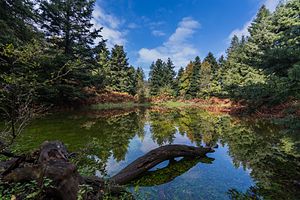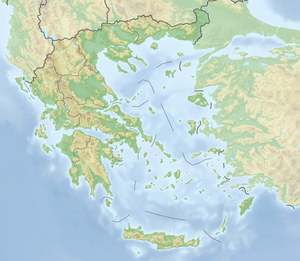Callidromo
| Kallidromo (Καλλίδρομο) | ||
|---|---|---|
|
Small lake in the Kallidromo massif |
||
| height | 1419 m (Kallidromo summit) | |
| location | Fthiotida Regional Unit , Central Greece | |
| Mountains | Kallidromo Mountains | |
| Coordinates | 38 ° 44 ′ 0 ″ N , 22 ° 34 ′ 0 ″ E | |
|
|
||
Kallidromo ( Greek Καλλίδρομο ; Katharevousa Kallidromon Καλλίδρομον, rarely also Kallidromos ) is a maximum 1419 m high mountain massif in the south and southwest of the regional district of Fthiotida in the Greek region of Central Greece . The name of the mountain means 'good way'.
geography
The Kallidromo massif begins in the north on the lower reaches of the Sperchios , which lies in its valley on its southern boundary. From the north, the Kallidromo ridge runs south-east along the coast of the Malian Gulf and then the northern Gulf of Evia . The longitudinal axis of the Kallidromo massif runs from northwest to southeast and has a maximum extension of 38 to 40 km. The vertical transverse axis for this from northeast to southwest has a diameter of approx. 16 km at the widest point and approx. 10 km at the narrowest point. The eastern and southern borders of the Kallidromo are made by the river Kifisos and its valley or plain.
To the north the Kallidromo massif runs out towards the level of the Sperchios with the summit Elafovouni with almost 1100 m height. Elafovouni is just north of the Kallidromo main summit, about 4 km away. In the middle of the longitudinal axis of the Kallidromo, foothills extend to the southwest towards the northeastern foothills of the Parnassos . The connection between the two mountain ranges is interrupted by the Kifisos with a narrow valley running along the western flank of the Kallidromo. This point marks the separation between the upper Kifisos valley in the north-west and the lower Kifisos valley in the south-east with the expanded plain of the drained Kopaïs lake . At the point of the passage between the Kallidromo in the north and the foothills of the Parnassos lies the city of Amfiklia . The Kallidromo massif runs south with the Varvas mountain . To the northeast towards the sea, the foothills called Knimis or Knimidos (926 m altitude) extends close to the coast. To the southeast, the foothills of the Kallidromo still reach a height of 841 m near the Profitis Ilias monastery north of Elatia.
The southeastern neighboring mountain or mountain is the Chlomo south of the small town Atalandi (Atalanti). To the south and southwest, the Parnassos is the neighboring mountains of the Kallidromo, from west-southwest to west the Vardousia massif, from west to northwest the Oite massif .
history
In ancient times the foothills of the Kallidromo were much closer to the sea. The northern part of the Kallidromo formed the land border of the Thermopylae Pass between the valley of the Sperchios and Boeotia as well as Attica . Due to the considerable sediment inundation of the river Sperchios in the Malian Gulf, there has been an increasing siltation over the years since antiquity , so that nowadays Thermopylae is several kilometers wide. Further south between the villages of Kamena Vourla and Agios Kostandinos , the foothills of the Kallidromo reach up to 500 m to the northern Gulf of Evvia and thus represent a traffic bottleneck of the present (and also of the past).
This strategic position as the “boundary wall” of the Thermopylae Pass has made the Kallidromo massif into a mountain massif that has been significant and worth mentioning several times in history. The repeated armed conflicts at the Thermopylae Pass always took place "at the feet" of the Kallidromo. At the first battle of Thermopylae in 480 BC. During the Greek campaign of the Persian Empire under Xerxes, parts of the Persian armed forces bypassed the Greek defensive positions under the Spartan King Leonidas on a path over the heights of the Kallidromo massif, only to stab the Greeks in the back. The defensive battle of the Greeks against the Celts in 279 BC. As part of their invasion of Greece and the so-called second battle at Thermopylae in 191 BC. And the defensive struggle of the Greek and Allied troops in the Second World War against the German Wehrmacht at the end of April 1941 were fought at the foot of the Kallidromo.
The strategic location of the Kallidromo as well as the immediately adjacent fertile plains of the Kifissos, the Sperchios and the Kopais lakes have made the area a place of many human settlements since ancient times. At the foot of the Kallidromo massif in the lower Kifissos valley was the ancient city of Elateia (Elatia). In the upper Kifissos valley, however, opposite the Kallidromo at the foot of the Parnassos, was the ancient city of Lilaea near today's Lilea .
In ancient times (see map), the Kallidromo massif was a divider between four ancient landscapes. In the north-west and north of Mali , in the west and south-west Doris , in the south and south-east Phocis and in the south-east and east Lokris . The Phokers had a narrow passage to the coast to their port of Alpenoi and thus separated the Lokrians in the east from the Malians and Dorians in the west. Other settlements and cities in the Kallidromos massif or its immediate vicinity were Herakleia Trachinia , Antikyra , Anthele and Skarphia .
population
At the present time the Kallidromo massif and its surroundings are quite densely populated. In the north are the villages of Ano and Kato Damasta. The villages of Agia Triada, Skarfia, Agios Serafim, Kenourgio, Longos, Goulemi, Kalypso and Arkitsa lie along the eastern flank of the Kallidromo by the sea. Cities are Molos, Kamena Vourla, Agios Kostandinos and at the southeast end of the Kallidromo Livanates and Atalandi (Atalanti). On the western flank inland are the cities of Elatia, Kato Tithorea and Amfiklia as well as the villages of Katalima, Lefkochori, Panagitsa, Modi, Xyliki, Tithronio, Drymea, Paleochori, Bralos, Ano Bralos, Skamnos and Eleftherochori. In the heights of the Kallidromo massif itself there are only the villages of Kallidromo, Mendenitsa, Karavidia and Reginio.
traffic
The outstanding position of the Kallidromo and its surroundings in terms of traffic in antiquity has not changed in the present despite the silting up and thus widening of the Thermopylae Pass. Both inland on the west side and along the sea on the east side, the most important traffic axes from north to south Greece run around the Kallidromo massif. On the west side of the mountain range coming from Lamia the national road 3 (Greece) (European route 65) runs over the Bralos pass between Kallidromo and Oiti as well as Giona and Parnassos via Amfiklia to Livadia and Thiva (Thebes). The course of the road leads after the Bralos Pass through the upper and lower valley of the Kifissos along the west side of the Kallidromo mountain range. On the eastern side along the sea, the national road 1 (Greece) (European route 75) runs from Thessaloniki via Lamia along the coasts of Thermopylae and the Knimidos mountain past to Athens In the course of the expansion of the national road 1 to the motorway 1, the sections to Livanates and Atalandi had already been expanded as a two-way motorway in the 1990s. The traffic-related importance will continue to increase because the highway 3 (Odos Kendrikis Elladas) under construction from October 2007 will lead from Panagia to highway 2 via Kalambaka , Trikala and Karditsa past Lamia west to Anthili north of the Kallidromo and south of Lamia .
The Thessaloniki-Larisa-Lamia-Athens railway line currently runs over the Bralos Pass from Lamia into the upper Kifissos Valley and then along the western flank of the Kallidromo to Livadia and on to Athens. In the course of the expansion of this line to a double-track high-speed line, the route will be relocated ( Tithorea – Domokos railway line ). The Brallos pass is no longer passed, but the railway line is led along the coast from Lianokladi via Thermopylae to southwest of Molos. At Molos the route swings south towards the Kallidromo massif and disappears in a 9.2 km long railway tunnel with two tubes. It exits the tunnel on the western flank of the Kallidromo and swings back to the original route at Kato Tithorea. The tunnel has been under construction since 1997, the breakthrough took place in 2013, and completion (as of 2013) should take place by 2015 [obsolete] .
literature
- Sterea Ellada. 1: 250,000. Road Editions, Athens, ISBN 960-8481-16-3
- Marco Polo Greece road map. 1: 750,000. MAIRDUMONT, Ostfildern; Edition: runs until 2008 (January 2005), ISBN 3-8297-3020-9

